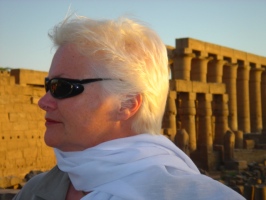“Rejected suitors take to roaming as naturally as unhived bees.” It’s a phrase from English poet and novelist Thomas Hardy (1840–1938) and refers to Diggory Venn (in Arthur Hopkins’ illustration, below).

Venn is perhaps my favorite of the Hardy characters in the novel Return of the Native. If the hive is Wessex (Hardy’s partly real, partly fictionalized Dorset county in south central England) and Venn the bee, then he does indeed take to roaming to become a red-stained nomad.
Venn has been rejected by Thomasin Yeobright, a young woman whose family tells to pursue a more “professional” husband. Venn then quits dairy farming to become a wandering reddleman, servicing sheep in the area. Reddle is a powdery red dye (an impure, earthy variety of hematite) used by sheep farmers to identify their flocks, perhaps more specifically, rams. (Spray paints or paste and ear tags are now used by sheepmen.) Venn lives and travels about in a small, horse-drawn shepherd’s hut (such as in the illustration below).

If Hardy, a native of Dorset, had joined me on my bus ride, he’d have seen the same exquisite, emerald-green hills strewn with popcorn dots of sheep. If he’d continued to rattle along with me another 14 miles through that country as I journeyed south, he would have enjoyed the sunshine in Weymouth, a seaside resort he visited from time to time.
I took several buses during my time in southwest England, one to Lyme Regis and one to Dorchester, and had the opportunity to view the lusciousness of Dorset and east Devon scenery from my windows. So incredibly lovely, with lines of trees like botanical embroidery stitches defining farms and pasturelands.
In Dorchester I also examined the Hardy collection arranged among the fossils and manufacturing memorabilia at the chock-a-block Dorset County Museum. Their collection includes a recreation of Hardy’s study, complete with pens supposedly used to write his various novels, where characters struggle with passion, social circumstance, and a changing rural culture.
It helped my own culinary passions that, after viewing the museum, I could partake of a chutney-dotted ham-and-Stilton cheese-infused ploughman’s lunch at The Old Tea House (below) where Hardy had also often stopped.

And, even though this unhived bee had wanted to see Hardy’s homes, old haunts, and the tearooms he frequented, it was the rolling hills and gorgeous countryside that really gave me the sense of the slow-paced agricultural village life he celebrated.

Post a Comment